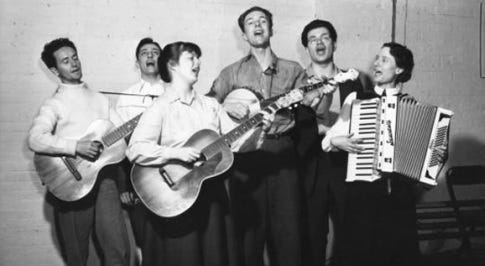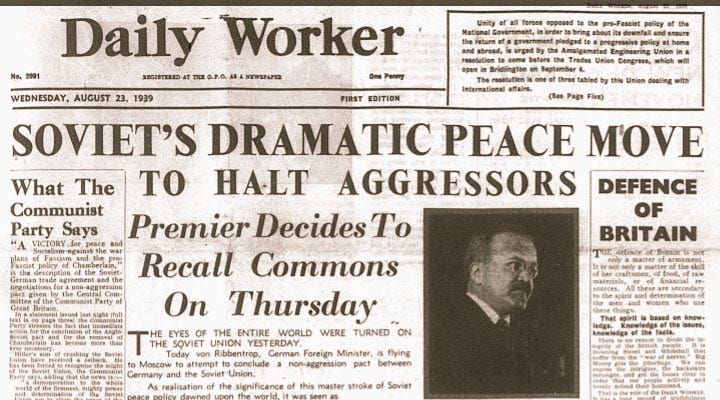"Which side are you on, boys..."
Watching the Ken Burns on the U.S. and the Holocaust and thinking about American folk music.
(This is the first part of a three-part post. Part Two here. Part Three here.)
The Ken Burns series “The U.S. and the Holocaust” drew me somewhat unexpectedly back into thinking about American music: pop, country, r&b, folk (I guess let’s just say “vernacular”). I’ll clarify that possibly weird connection in this post, but maybe someday, in another post, I’ll consider as well why this series is one of the few Burns efforts I’ve found compelling and enlightening. I think it has something to do with its not being a huge survey-type overview of a thick slice of Americana, like the Civil War, baseball, jazz, or even Vietnam. Also there’s very little opportunity to show “the dark side” and then segue into “but ain’t that America—on balance it’s all more or less good intentions anyway.” This one’s almost all dark-side. The few elements of minor uplift came as a huge relief, at least to me.
And I was—"happy” isn’t quite the right word—to see the realities of that period in the U.S., so often airbrushed, brought to painful life. Plus a lot of amazing footage, of course.
For today, though, I’ll just note that the series reminded me how deeply the American public didn’t want to go to war in the 1930’s, and didn’t want to accept refugees; how isolationism connects with antisemitism and xenophobia and nativism; and how long we’ve had major episodes of Trumpist anti-immigration nationalism in this country.
Back then, plenty of people felt no need to cover it up or even downplay it. We’re seeing a revival of that mood now. In between, some things got a lot better.
On the other hand, some Americans had reasons other than antisemitism, xenophobia, and fascist and fascist-adjacent sympathies to want to keep the U.S. out of WWII. It’s not in the show’s brief to explore those reasons—the Jewish-refugee issue provides a strong focus—but I think the other branches and shoots make an important adjunct to the main action.
I’ve always been especially interested in antiwar efforts made by the U.S. left of the day. It's a story that connects the global politics of Russia, Europe, and the U.S. with the horrible long sufferings of Ukraine, so it refracts our current tense period of crisis, during the current war, over what kind of U.S. involvement might or might not be warranted. The story also connects—crucially for me—with American musical and folk-revivalist fantasies that I’ve written about on this blog and elsewhere: here and here and here.
It begins once upon a time, before June of 1941, when the folk-singing American left opposed U.S. entry into WWII.
Not, of course, for the isolationist, white-supremacist reasons of a Charles Lindbergh. This opposition had to do with a commitment to equality. The Almanac Singers, a young folk-revival group that included at various times Pete Seeger, Woody Guthrie, Bess Lomax, Josh White, Lee Hays, Millard Lampell, Sis Cunningham, and others, played agit-prop songs at progressive events in lofts and apartments around New York City in support of labor organizing and civil rights; their repertoire was not only anti-racist, anti-capitalist, and pro-labor but also anti-war, specifically anti-U.S. involvement in WWII.
So that looks like a pretty classic case of the young idealism that can see clearly, and rightly enough, the horrible effects of war, especially as a modern, industrialized enterprise in which a lot of investors get rich. Given what had come to light about WWI, and especially before Hitler’s real aims were fully understood—a lot of experienced people got that wrong—associating an antiwar attitude with progressive causes and criticism of the capitalist powers of the day might have made a lot of sense.
But the Almanacs weren’t really singing for peace. They were following what was known as the party line.
The term has become a cliché, but back then it was literal: the policy of the Communist International, borne out via the Communist Party—in the case of the Almanacs, the Communist Party of the United States—as communicated via The Daily Worker, which came out, per its name, daily, and let readers know what the party line was. Because the line could change.
The Communist International met in Moscow, the capital of the Soviet Union, the first communist country and thus in the vanguard of the international communism that was supposed to be demolishing capitalism worldwide. So the party line had it that the Soviet Union’s aims were to be advanced and defended by all Communists internationally.
The historic territorial desires of Russia were thus woven into an ideological global showdown over the future of capitalism—really the future of humanity. In 1939, when Hitler, the dictator of Germany, and Stalin, the dictator of the Soviet Union, signed a mutual non-aggression pact, any U.S. involvement in a war against Hitler, the party line now had it, ran contrary to the aims of international Communism, as represented by the policy of Stalin’s Russia.
A major issue. But not necessarily a factor, one might think, in what a bunch of idealistic American youngsters would sing and not sing. It was a factor, though, and a decisive one, because cultural efforts were key to the larger effort for international Communism. Back in 1935, the party line had established a Popular Front: Communists were supposed to ally with certain liberal efforts like the New Deal; the popular arts were a big part of the program, and the American folk left was committed to changing the world through music.
Their music. Folk music. The people's music.
So in 1939, with the changing of the party line on the Popular Front, the Almanac Singers followed the line. Along with labor songs, they wrote and sang songs criticizing the efforts that FDR was then making, short of war, to support the Allied powers in fighting Hitler. They didn’t like to think of it this way—their minds were on higher things—but in fact they were singing on behalf of a deal made between Hitler and Stalin for control over Poland.
Reviewing this history can be divisive, not surprisingly. Some people want to lambast the ‘30’s American left for its naïve-at-best Stalinism and attack any nuance as excuse-making. Others want to complicate the fact that artists like Guthrie and Seeger were following the Soviet line, when it's really not complicated: they were. The appeal that Soviet communism held for the American left of the day remains hard to reckon with. And maybe that’s natural enough, given what Soviet communism was.
But if you were pro-labor and anti-racist in America the 1920s and ’30’s, it might have had appeal for you too. My experience with the countercultural protests of forty or so years later suggests to me it might have had appeal for me. I can also imagine finding the CIA kind of appealing too, in the years before the Bay of Pigs.
Romance is a heavy drug. It’s easy to ignore a lot of bad affiliations when you’re impassioned.
Labor was beaten down. Black people were lynched. The U.S. Communist Party was one of the few sectors where anybody seemed to give a damn about all of it, as a single set of interrelated problems, and to have a big idea for totally and permanently changing the underlying conditions.
It's also worth remembering that party lines and their reversals were by no means the exclusive property of communism. The liberal western powers had hoped, at first, that Hitler would knock out communist Russia. In the late ’30’s, when the Soviet diplomat Litvinov advanced a plan for a concerted bottling up of Nazi Germany, the democracies turned their backs. That had a lot more to do with resulting horrors than the Soviet-influenced anti-war stance of the Almanac Singers.
On the other hand, as early as 1922, the radical feminist and socialist Emma Goldman, who lived in the United States for almost 25 years, saw what was really going on in Russia and denounced it. And she wasn’t talking about Stalin—that was in Lenin's time. Though repeatedly imprisoned by the US, and ultimately deported to the USSR, Goldman got the Russian situation right away. Some on the American left couldn’t see it for many years.
Another reason to absolve the Almanac singers of at least some responsibility—not for being pacifist, a legitimate position, but for presenting their Hitler-Stalin songs as peace songs—is that the music they made couldn’t possibly have had any significant impact on anything political.
This statement too may be divisive:
Their music itself is objectively terrible.
Obviously that’s a matter of opinion, though I don’t experience it that way, and I generally don’t like agit-prop anyway, but to my ear, most of their stuff isn’t even good agit-prop, musically or politically. If you don’t know the Almanacs' music, if you’re thinking it might be something like Guthrie’s great solo work, or the music of the great Lead Belly, it’s nothing like that. I don’t like the Weavers, but even if you do, musically this stuff is the weakest imaginable early iteration.
But maybe people at lefty fundraisers liked the Almanacs at the time. The group did record a couple of albums, but it’s not as if they were breaking through to a big toe-tapping audience and shaping how Americans thought about anything; they were just rallying the like-minded and dramatizing the party line for a small group of pre-sold aficionados. If you want to blame somebody for keeping the U.S. out of WWII for so long, the Almanac Singers' are not your culprits.
And yet as insipid, to my ear, as their music is, as wrongheaded as some of its origins, it was influential—not on public opinion, but on certain aspects of American vernacular music that we know today. In my next public post, I’ll embed a few audio examples of the Almanacs’ recordings and consider them in the context of considering some other protest music, and maybe that whole genre's relationship to traditional American music, and maybe to middle-class youth-culture affectations of working-class style. . . .
But I’ll also look at what happened to change the Almanacs' minds about the Allied position—it wasn’t Pearl Harbor!—and what they said about it later, when they looked back at a tense, scary time that has tense, scary resonances for our own time. Here’s a preview. Maybe you’ll even like this—that’ll make things interesting.




